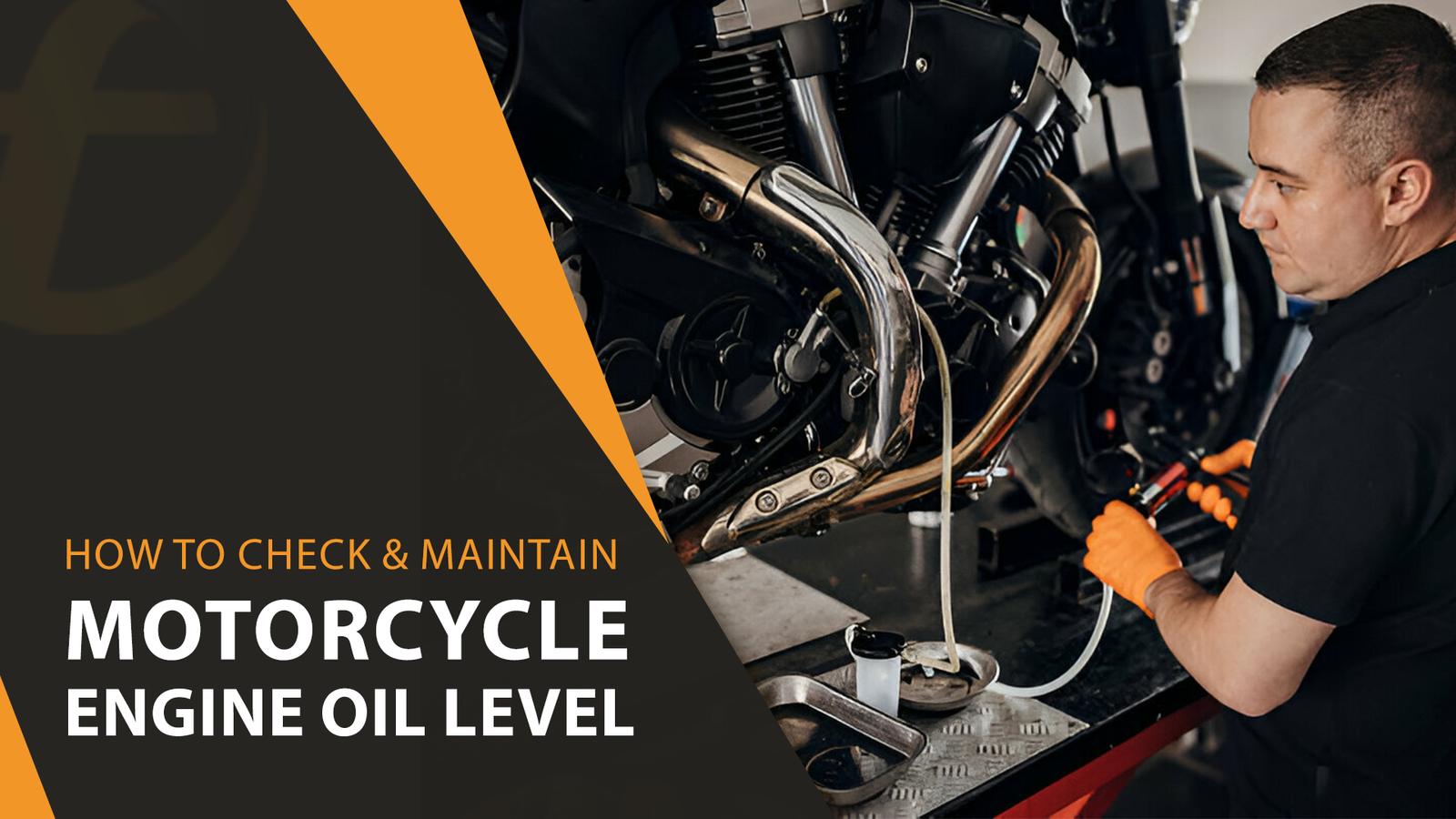
Ensuring your motorcycle’s engine stays healthy is crucial for its long-term performance. Refrain from maintaining maintenance, such as monitoring oil levels, can lead to serious damage.
Low oil levels may result in rough engine sounds, overheating, or even engine seizure. Moreover, inadequate oil levels increase the risk of contaminant buildup, further compromising engine function.
Preventing contaminant buildup is essential to maintaining optimal performance and longevity. It involves regular oil changes and using high-quality oil filters to remove contaminants and prevent further buildup.
We have made a simple guide to help you check and maintain your motorcycle engine oil level. This will help your engine last longer and perform better.
Required Tools
- Pliers
- Rag
Steps to Check Motorcycle Engine Oil Level
Before you begin, make sure to park the bike on a flat surface. Checking the engine oil level with the motorcycle parked on rough terrain or a slope won’t give you an accurate reading, so it’s important to keep it level.
You can utilize the centre stand, or the paddock stands to maintain the bike in an upright position. As long as the bike is standing straight and not leaning to either side, either stand will work fine.
You also need to ensure that you warm up the engine to its operating temperature.
Turn off the bike. Wait 15 minutes. Allow the oil to drain back into the pan. Measure it for accuracy.
Next, refer to your bike’s manual to determine how to check the oil level. Some bikes use a dipstick, while others have an inspection window. If you don’t have the manual, you can search for the bike’s model number on Google to find the information online.
Sight Glass
Most modern motorcycles feature a sight glass, providing a straightforward method for checking the oil level. Your manual should specify its location.
This little window shows how much oil is in the bike, with a marker showing the right amount of oil. Typically, it would help if you filled the sight glass to about three-quarters full.
Dipstick
If your bike utilizes the dipstick method, start by finding the oil cap/gauge and then removing it. If it’s tightly fixed, you may need to use a pair of pliers.
Once the oil cap is off, wipe it with a clean rag to ensure it’s dry. The oil cap features a gauge at the tip indicating the oil level, with markings for full or low.
Next, reinsert the oil cap without screwing it in. After submerging it, remove it to check the oil level using the markers on the oil cap. Target approximately three-quarters full on the marker.
Environmental Impact
Maintaining your motorcycle’s engine oil level is essential to prevent environmental harm. Oil leaks or spills can contaminate soil and water, endangering ecosystems and wildlife.
Proper handling and disposal are crucial to mitigate these risks and protect the environment. It’s important to handle and dispose of oil carefully to avoid harming the environment.
Addressing leaks or spills minimizes your environmental footprint, preserving nature’s delicate balance and ensuring the conservation of resources for future generations.
Responsible maintenance practices benefit both the environment and your riding experience. Prevent oil leaks to protect the environment and enjoy motorcycle riding without worrying about spills.
Visual Inspection Tips
Here are visual inspection tips to help you check and maintain the engine oil level:
- Park on a Level Surface: To get an accurate reading, ensure your motorcycle is upright and on a stable, level surface.
- Engine Temperature: Check the oil level when the engine is cool. A warm engine can give you a false reading.
- Oil Inspection Window: Most motorcycles have a sight glass or inspection window. Clean the area around it with a rag to see the oil level clearly.
- Dipstick: If your bike uses a dipstick, unscrew it and wipe it clean for an accurate measurement.
- Stand the bike upright: This may require assistance if your motorcycle doesn’t have a centre stand.
- Check the Oil Level: The oil should be between the upper and lower marks on the inspection window. The colour should be golden or light brown for healthy oil.
- Colour and Texture: The oil should be transparent enough to see through it on the dipstick or sight glass. If it’s dark, thick, or gritty, it’s time for a change.
- Contaminants: Be on the lookout for metal filings or debris, a sign of internal wear that needs immediate attention.
What Do Different Oil Colours Mean?
- Amber: An amber colour indicates that your oil is in good condition and healthy.
- Dark/Black: If your oil looks dark or black, it indicates that you need to change it.
- If the oil is milky white, it may mean coolant has been mixed in. This could be a sign of a blown head gasket or other engine problems. Having a mechanic check it out right away is important. Having a mechanic check it out right away is important.
Understanding Oil Levels and Conditions
Understanding oil levels and conditions is vital for keeping your motorcycle running smoothly and preventing potential engine damage. It allows you to detect issues early and take corrective action, ensuring optimal performance and longevity.
Interpreting Different Oil Levels
Understanding the significance of different oil levels in your motorcycle’s engine is important. Here’s what different oil levels indicate:
- If the oil level falls between the full and low marks, it indicates the correct level, requiring no adjustments.
- If the oil falls below the low mark, it’s time to either refill it or consider an oil change.
- If the oil exceeds the full mark, it’s a problem. You’ll need to drain off the excess oil.
Decoding Oil Colors and What they Indicate
The colour of the oil can provide valuable insights into the condition of your motorcycle’s engine. Here’s what different oil colours indicate:
Black or Dark Brown Color
Dark brown or black motor oil in your motorcycle means it’s dirty or overheated. This shows it needs an oil change, especially if you see dirt or debris.
Using this oil further could damage your engine and lead to expensive repairs, so get it serviced soon.
Cream or Milky-Colored
If you see your motorcycle’s motor oil looking creamy or milky, it might mean there’s moisture. It could also signal a head gasket leak, which requires swift attention from a motorcycle repair technician to prevent pricey damage. If you spot white exhaust smoke or notice faster coolant loss, it’s important to get it checked.
Cream Or Milky-Coloured With a Frothy Texture
When checking the motor oil colour, remember the texture. If it looks creamy or milky and feels frothy, there’s probably moisture in it. If you don’t see signs of a head gasket leak, like coolant loss or white smoke, then it’s likely water in the oil.
Bottom Line
In short, it’s essential to check and maintain motorcycle engine oil levels. A simple yet effective way to ensure its performance and longevity. Regularly checking your oil and understanding its condition can prevent future issues and keep your motorcycle running well. Remember, taking care of your bike means it will take care of you on the road.
FAQs
Q1: Can I use any oil for my motorcycle?
Ans: Motorcycle manufacturers usually need higher viscosity compared to those used in passenger cars. Common grades for motorcycles include 5W-40, 10W-40, 10W-50, and 20W-50.
Q2: How often should I check my oil level?
Ans: Mostly, it’s good to check your oil level every day or before any long ride.
Q3: What happens if I neglect oil maintenance?
Ans: If you ignore your motorcycle’s oil for too long, it could result in complete engine failure. Old, dirty oil can damage the engine’s insides, and fixing it can be extremely expensive.











